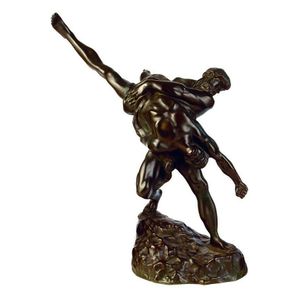French Empire Swans Wall Sconces
You must be a subscriber, and be logged in to view price and dealer details.
Subscribe Now to view actual auction price for this item
When you subscribe, you have the option of setting the currency in which to display prices to $Au, $US, $NZ or Stg.
- Gilding - Gilding is a method of ornamentation whereby a thin sheet of gold metal is applied to items made of wood, leather, ceramics, glass and silver for decorative purposes.
For furniture including mirrors, the sheet of gold is usually applied over a coating of gesso. Gesso is a mixture of plaster of Paris and gypsum mixed with water and then applied to the carved wooden frames of mirrors and picture frames as a base for applying the gold leaf. After numerous coats of gesso have been applied, allowed to dry and then sanded a coat of "bole", a usually red coloured mixture of clay and glue is brushed on and allowed to dry, after which the gold leaf is applied. Over time parts of the gilding will rub off so the base colour can be seen. In water gilding, this was generally a blue colour, while in oil gilding, the under layer was often yellow. In Victorian times, gilders frequently used red as a pigment beneath the gold leaf.
Metal was often gilded by a process known as fire gilding. Gold mixed with mercury was applied and heated, causing the mercury to evaporate, the long-term effect of which was to kill or disable the craftsman or woman from mercury poisoning. The pursuit of beauty has claimed many victims, not the least of which were the artists who made those pieces so highly sought after today. - Sconce - A light attached to a wall. Originally a candle holder that is attached to a wall with an ornamental bracket and sometimes with a reflective back plate, but now applied to an electric light that has been inspired by that design.
In recent times the word has also come into use to desribe the candle holders on a candelabra. - Parcel Gilt - An item or component that is partially gilded, the purpose of the gilding being to accentuate the decoration. For example a silver vessel may have gilded highlights, or the leg of a table or chair may have gilded carvings.
- Bronze - An alloy of copper and tin, traditionally in the proportions of about 9 parts of copper to 1 part of tin.
The discovery of bronze in Western Asia in the 4th century enabled people to create metal objects which were superior to those previoulsy possible because of its strength and hardness, and it has been used throughout the world for weapons, coins, tools, statuary and other decorative items.
It is very fluid in a molten state, and its hardness, strength when set, and non-corrosive properties makes it most suitable for casting sculpture.
This item has been included into following indexes:
Visually similar items

A kangaroo pendant, 9 carat yellow gold. Length 2 cm. Weight 1g

A gold fish pendant on chain, 9ct yellow gold, made as a stylised tropical fish in ribbed and polished gold, suspended from a simple gold coloured trace link chain. Length 45 cm fish weight: 4.7grams

An 18ct gold diamond spray brooch, set with 13 mixed old European and round brilliant cut diamonds totalling an estimated 1.10ct, size 41 x 33 mm, wt. 6.7g.

Jeff Lambeaux (Belgian 1852-1902) 'Lutteurs', (Wrestlers), bronze sculpture with dark patina, the base cast with the artist's name, c.1897. Height 65.5 cm
